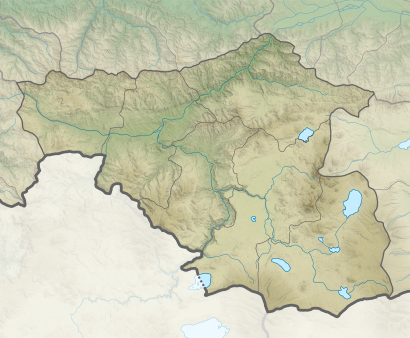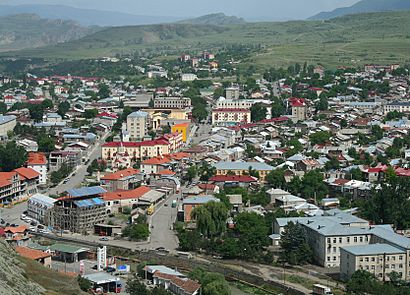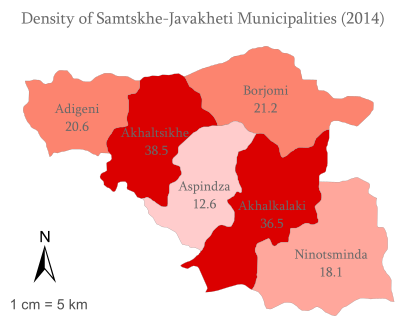Samtskhe–Javakheti facts for kids
Quick facts for kids
Samtskhe–Javakheti
სამცხე-ჯავახეთი
|
|
|---|---|
 |
|
| Country | |
| Seat | Akhaltsikhe |
| Subdivisions | 6 municipalities |
| Area | |
| • Total | 6,413 km2 (2,476 sq mi) |
| Population
(2021)
|
|
| • Total | 151,110 |
| • Density | 23.5631/km2 (61.028/sq mi) |
| ISO 3166 code | GE-SJ |
| HDI (2017) | 0.734 high · 9th |
Samtskhe–Javakheti (Georgian: სამცხე-ჯავახეთი) is a region in southern Georgia. It has about 151,110 people (as of 2021) and covers an area of 6,413 square kilometers. The main city and administrative center is Akhaltsikhe. The governor of the region since August 2018 is Besik Amiranashvili. Samtskhe–Javakheti is made up of three old Georgian areas: Meskheti, Javakheti, and Tori.
Some very important pipelines and a railway pass through this region. These include the Baku-Tbilisi-Ceyhan oil pipeline, the South Caucasus natural gas pipeline, and the Kars–Tbilisi–Baku railway. These are vital for moving energy and goods across countries.
Contents
Exploring the Geography of Samtskhe–Javakheti
Samtskhe–Javakheti shares borders with several other regions in Georgia. To the northwest, it borders Adjara and Guria. To the north, it borders Imereti, and to the northeast, Shida Kartli. In the east, it borders Kvemo Kartli. Its southern border is with Armenia, and its southwestern side touches Turkey.
Mountains and Plateaus
The region includes the Javakheti Plateau, which is a high area formed by volcanoes. This plateau is part of the northern Armenian highlands. The flat areas here are very high, usually between 1,500 and 2,000 meters above sea level. Samtskhe–Javakheti is surrounded by several mountain ranges. The most important ones are the Meskheti Range and Trialeti Range in the north, and the Samsari Range and Javakheti Range in the east.
Lakes and Rivers
Many of Georgia's largest lakes are found in these highlands. Some of these beautiful lakes include Paravani Lake, Tabatskuri Lake, Khanchali Lake, and Kartsakhi Lake.
Georgia's longest river, the Mtkvari, flows through this region. It enters Georgia from Turkey, just a few miles north of Kartsakhi Lake. The river has carved a deep canyon through the highlands. This canyon forms the eastern edge of the Erusheti Highlands, which is a mountain range along the border with Turkey. Inside this gorge, you can find the famous historic cave monastery called Vardzia, which is a major tourist spot.
The Mtkvari River first flows northwest through the gorge to Akhaltsikhe. Near Akhaltsikhe, the Paravani River joins the Mtkvari. The river gorge here is about 500 meters deep. At Akhaltsikhe, the river changes direction and flows northeast towards Borjomi. It passes between the Meskheti Range on its left bank and the Trialeti Range on its right bank. After Borjomi, the river leaves the region and flows into the Shida Kartli plain.
Climate and Winter Sports
Because it is located so high up, the region has cold winters with a lot of snow. In the northern part of the region, near the famous town of Borjomi, you can find the Bakuriani ski resort. This is a popular place for winter sports.
How Samtskhe–Javakheti is Divided
The region of Samtskhe–Javakheti is divided into six smaller areas called municipalities. These municipalities have 82 smaller administrative communities and a total of 271 towns and villages where people live.
Here's a breakdown of the types of settlements:
- Five cities: Akhaltsikhe, Akhalkalaki, Borjomi, Vale, and Ninotsminda.
- Two small towns (called dabas): Kharistvala and Lentekhi.
- 259 villages.
| Map | Municipality | Area (km²) |
People per km² (Density) |
|---|---|---|---|
| Adigeni | 799 | 20.1 | |
| Akhalkalaki | 1,235 | 33.2 | |
| Akhaltsikhe | 998 | 39.5 | |
| Aspindza | 825 | 12.8 | |
| Borjomi | 1,202 | 20.8 | |
| Ninotsminda | 1,354 | 14.0 | |
| Population density is based on the 2021 population. | |||
People of Samtskhe–Javakheti
As of January 1, 2021, Samtskhe–Javakheti had 151,110 residents. This number is a bit lower than in 2014. Most people (64.1%) live in villages, while 35.9% live in cities. The municipalities of Akhaltsikhe and Akhalkalaki have the most people.
| How the population of Samtskhe–Javakheti has changed over time | ||||||||||||||||||
|---|---|---|---|---|---|---|---|---|---|---|---|---|---|---|---|---|---|---|
| 1959 | 1970 | 1979 | 1989 | 2002* | 2002** | 2014 | 2021 | |||||||||||
| Samtsche-Dzjavacheti | 213,329 | |||||||||||||||||
| Akhalkalaki | 62,977 | - | ||||||||||||||||
| Akhaltsikhe | 50,420 | - | ||||||||||||||||
| Adigeni | 19,593 | - | ||||||||||||||||
| Aspindza | 11,265 | - | ||||||||||||||||
| Borjomi | 37,010 | - | ||||||||||||||||
| Ninotsminda | 32,064 | - | ||||||||||||||||
| * A study after the 2014 census showed that the 2002 census numbers were a bit too high. ** This is corrected data based on studies done with the United Nations. |
||||||||||||||||||
Different Ethnic Groups in the Region
Samtskhe–Javakheti is home to many different ethnic groups. In 2014, the total population was 160,504 people.
- Armenians made up about 50.52% of the population (81,089 people).
- Georgians made up about 48.28% (77,498 people).
- Russians were about 0.44% (712 people).
- Other ethnic groups made up about 0.74% (1,194 people).
A Brief History of Samtskhe–Javakheti
The way Georgia is divided into "regions" (called Mkhare) today started in the mid-1990s. This was done partly to respond to conflicts in other parts of Georgia. Samtskhe–Javakheti was created by joining two older, traditional areas: Meskheti (also called Samtskhe) and Javakheti.
The Story of Meskheti
The first known people to live in the Meskheti area were ancient tribes called the Meskhi and Mosiniks. Some historians believe the Mosiniks were the first to discover how to work with iron.
For a long time, Meskheti was part of different ancient kingdoms. From about 2000 BC to 400 BC, it was thought to be part of the Kingdom of Diauehi. Then, from 400 BC to 600 AD, it was part of the Kingdom of Iberia. Later, from the 10th to the 15th century, it was part of the united Georgian Kingdom.
In the 16th century, Meskheti became part of the Safavid Empire, and then the Ottoman Empire. After a war between Russia and Persia (1826-1828), it became part of the Russian Tiflis Governorate from 1817 to 1829. Later, it was part of the short-lived Democratic Republic of Georgia (1918-1921) and then the Georgian SSR (1921-1990). When Georgia became independent from the Soviet Union, Meskheti was re-established as a province and later became part of the new Samtskhe–Javakheti region.
The Story of Javakheti
Ancient records mention the Javakheti region as Zabakha in 785 BC. This was written by King Argishti I of Urartu. Historians believe that Javakheti was part of the Iberian duchy of Tsunda from the 4th or 3rd century BC.
Saint Nino, a very important figure in Georgian history, entered Iberia through Javakheti. She followed the River Kura to Mtskheta, the capital. There, she began to teach about Christianity, which led to the Christianization of Iberia.
During the time of Arab occupation, the Bagrationi dynasty rose to power in the nearby region of Tao-Klarjeti. They gradually took back control of surrounding lands, including Samtskhe and Javakheti, from Arab control. For a long time, this region became a very important cultural and religious center for Georgia.
In the mid-10th century, Javakheti became part of the Kingdom of Abkhazia. In 964, King Leon III of Abkhazia expanded his influence to Javakheti. During his rule, the Kumurdo Cathedral was built. In the centuries that followed, Javakheti was a key part of the united Georgian monarchy. This was a time of great development, with many bridges, churches, monasteries, and royal homes (like Lgivi, Ghrtila, Bozhano, and Vardzia) being built. From the 11th century, Akhalkalaki became the main city of upper Javakheti. From the 10th century, Tmogvi was the center of lowland Javakheti. From the 12th century, the area was ruled by the noble Toreli family.
In the 15th century, Javakheti became part of the principality of Samtskhe-Saatabago. In the 16th century, the Ottoman Empire took control of the region. Many Georgian people living in Javakheti moved to other parts of Georgia, like Imereti and Kartli. Those who stayed slowly became Muslim.
Later, after wars between the Russian Empire and the Ottomans, Russian authorities encouraged Christian Armenians and Caucasus Greeks to settle in the area after 1828. Many Armenian refugees came in the early 20th century. Also, a large number of Russian Doukhobor people, who belonged to a religious group, settled in the region.
The Soviet Era
Georgia came under the full control of the Soviet Union in 1921, after the Red Army invasion of Georgia. During this time, a group of Muslim people in Meskheti, known as "Meskhetian Turks", were forced to leave their homes. They were put into cattle-trucks and sent to Central Asia by order of Stalin. They were settled in areas that are now part of Kazakhstan, Kyrgyzstan, and Uzbekistan. Many of them are still spread across these countries today. Out of 100,000 people who were forced to move, between 30,000 and 50,000 died.
Amazing Places to Visit in Samtskhe–Javakheti
This region has many fascinating places that tourists love to visit.
- The famous cave monasteries of Vardzia were founded by Queen Tamar in 1185.
- Vanis Kvabebi is another cave monastery that dates back to the 8th century.
- Rabati Castle is a beautifully restored fortress.
- Khertvisi Fortress is an ancient and impressive castle.
- Many local visitors also enjoy the 10th-century Sapara Monastery, the Tmogvi fortress, and the 8th-century Zarzma monastery.
See also
 In Spanish: Región de Mesjetia-Yavajetia para niños
In Spanish: Región de Mesjetia-Yavajetia para niños
- Subdivisions of Georgia





